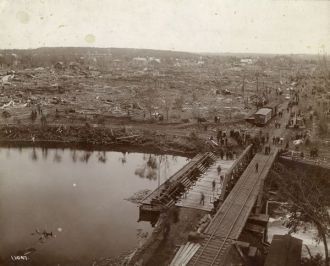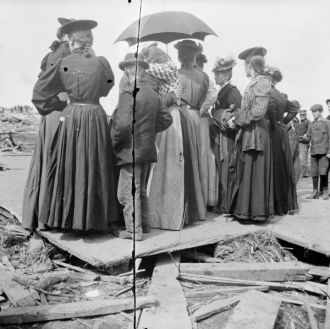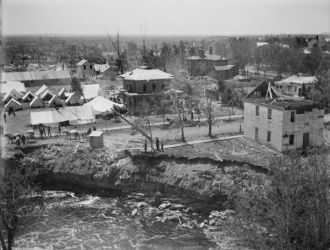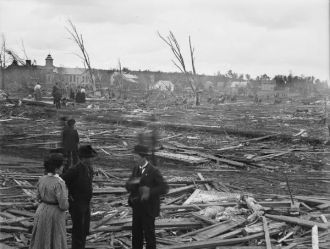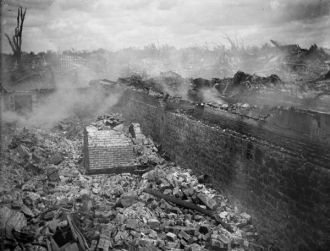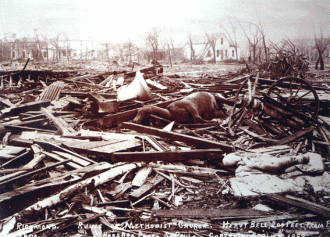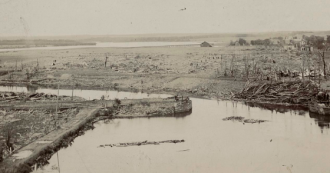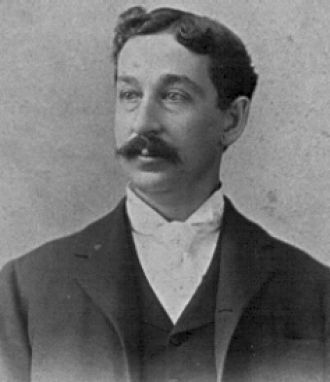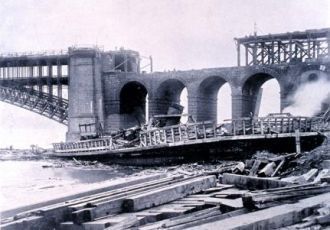USA, New Richmond, Wisconsin
The winter of 1898-99 had been an unusually severe one with snow so deep the sleighs rode on the hard crust over the fence posts buried beneath. Unrelenting cold climaxed in January at 60 degrees below zero. Old people and those in "delicate" health were house bound for months into a late spring.
"O! How we longed for summer!" wrote Anna Epley in her history of the cyclone, A Modern Herculaneum. "How we braced ourselves up in the freezing air, saying encouragingly to each other, "Wait patiently till the bright, beautiful summer comes. We will then forget we ever had such a severe winter. We will enjoy ourselves in our hammocks under the beautiful branches of our New Richmond's glorious trees! Where are they now? And the summer came, and brought us death!"
However, when the day of June 12, 1899 started, no one knew of the holocaust in store for them. It was a Monday; school had let out the previous Thursday. It was to be a gala day because of the Gollmar Brothers Circus was in town and the country people started coming in early. No one wanted to miss the big parade and the "monster menagerie and museum" or the "Mammoth two-ring circus." So, by coincidence, New Richmond was more filled with people than usual, many staying over the night after the festive occasion.
Morning is Peaceful Before Cyclone Disaster
Anna Epley described the peaceful city as that Monday began, telling of the milk and baker's carts on their round, the business houses opening for the day wearing "an air of prosperity and expectancy for the brisk trade in view," while the New Richmond Roller Mills ground its "famous flour."
As the day wore on, it became oppressively hot for a June day. By five o'clock the circus was over, and fortunately, because a light rain had begun falling, followed by a sluggish hail. By six o'clock, as people were heading home for supper, a few were beginning to notice the clouds that had formed about 5:30 p.m. above Lake St. Croix.
According to Mrs. Epley, an eyewitness described the cloud formation as follows: "A top-shaped cloud came dancing up along the lake; another mass or column of cloud came from the vicinity of Stillwater. These two clouds were merged together in a funnel-shaped column, or columnar mass, spreading somewhat at the top, and boiling or tumbling rapidly within itself. Thus agitated, it turned eastward, and skirting the hills south of Hudson and hugging the ground closely, it took a northeasterly course towards New Richmond."
On that course it followed, destroying and demolishing the clusters of farm buildings in its path.
Then, with a deafening roar and rumbling, the tornado swept down the length of New Richmond completely leveling what was estimated to be a strip about 1000 feet wide and 3000 feet long. Only the extreme western edge of the town escaped damage or destruction. Because of the timing, about 6 p.m., with many people on the streets on their way home for supper, and because of the crowd in town due to the circus, more than the usual number were out away from readily available shelter. The scene was one of confusion and terror as people belatedly realized what was happening.
Many did save their lives by fleeing to the cellars in the few seconds warning time they had. However, sometimes this shelter was not sufficient. The O. J. Williams dry good store on the corner of Third and Main Streets proved to be a real death trap. People on the streets in front of it rushed into the store for safety with the result that the building held one of the highest mortality rates in the city. The bricks were sucked up by the tornado and hurled back down on the crowd in the cellar.
The impression made by the disaster was carried throughout life by those who were there, both adults and children.
The black cloud was filled with flashes of light giving some the impression the end of the world had come. But before people had a chance to fully comprehend what had happened to them, another wind came up from the northwest, causing panic and people to head for cellars again. The wind brought with it a downpour of rain and falling temperatures, so that the people thinly clad for the day's heat, were cold and shivering without protection. The gale of wind and rain continued for over an hour.
But, there was work to be done. The immediate need was to search out family members and release victims trapped under the debris. Fires in many locations had instantly broken out following the destruction of the buildings. According to one observer, the fire was the "saddest and most horrible part of the whole affair." Any number of bodies were later discovered burned with no way of knowing whether the individuals had perished in the tornado or the ensuing flames.
All over the stricken city, survivors, many of the them in a state of shock and injured themselves, searched for family members or tried to release trapped people from the ruins. All telephone and telegraphic communication had been cut off so messengers were sent to Stillwater and Hudson to request help and medical supplies. The electric light plant had been destroyed, so much of the search was conducted by the light of the same fires which were causing such anguish. The city waterworks plant had been demolished, too, the hydrants and pumps ruined and wells filled up. It was difficult to find water, much less a pail to put it in.
Medical Help Was Badly Needed
Supplying medical help was an immediate need. Of the four drugstores in town, only splinters remained, and of the four doctors' offices, two were completely gone and the remaining two stripped of supplies and fill of dirt and fragments. A temporary hospital and a temporary morgue were both needed. The Congregational Church and the schoolhouse, while both were damaged, sufficed for the first, the Catholic Church for the second. The pastors of both churches, Mr. Adams and Fr. Degnan, were both cited for their courage and assistance in the disaster.
The first message to get out was sent from the telegraph office at Roberts, nine miles south of New Richmond. The first relief train arrived shortly after midnight from Chippewa Falls on the Wisconsin Central line. At each station along the route, the train had stopped and taken on more willing volunteers. Ten physicians were on this train as well as medical supplies. Doctors from Roberts and Hammond had arrived earlier. Because of the general filthy conditions and the lack of facilities, it was decided to send the injured to hospitals in St. Paul, extra trains being put on the line as soon as more victims were discovered and ready to transport.
Relief supplies, food, and money soon came pouring in from towns all over Wisconsin and neighboring Minnesota. Several pieces of fire equipment from St. Paul helped control the flames, and members of the militia sent to guard the city were a welcome relief to the surviving inhabitants. There had been several cases of people being stripped of their belongings while lying helpless and unable to defend themselves.
An impromptu court was established. Two ancient justices of the peace, each seated on a cracker box, dispensed liberal sentences to those who were caught pilfering.
Source: http://nrheritagecenter.org/cyclone.htm



 USA, New Richmond
USA, New Richmond